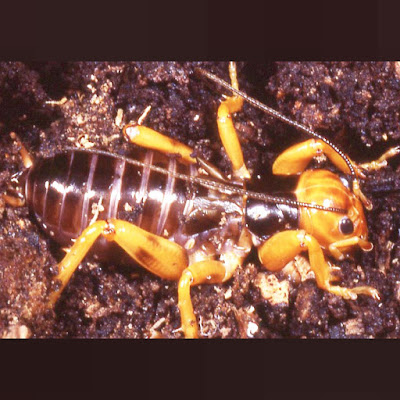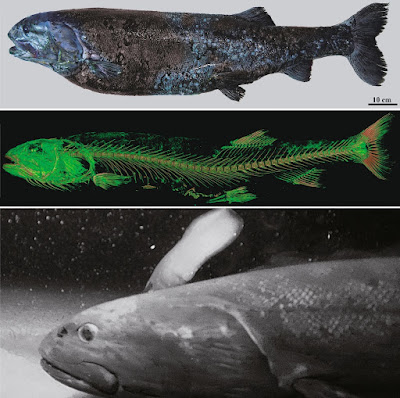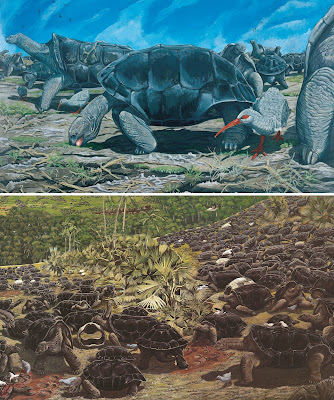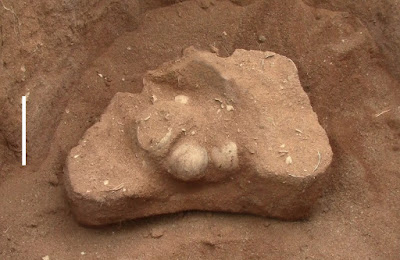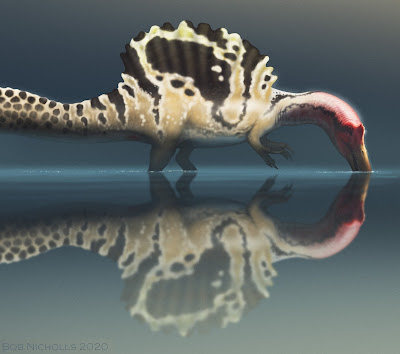[Most Recent Entries] [Calendar View]
Tuesday, January 26th, 2021
| Time | Event | ||||||
| 3:22a | [Entomology • 2021] Generic Relationships of New World Jerusalem Crickets (Orthoptera: Stenopelmatoidea: Stenopelmatinae), including All Known Species of Stenopelmatus
Abstract The New World Jerusalem crickets currently consist of 4 genera: Stenopelmatus Burmeister, 1838, with 33 named entities; Ammopelmatus Tinkham, 1965, with 2 described species; Viscainopelmatus Tinkham, 1970, with 1 described species, and Stenopelmatopterus Gorochov, 1988, with 3 described species. We redefine the generic boundaries of these 4 genera, synonymize Stenopelmatopterus under Stenopelmatus, and synonymize Viscainopelmatus under Ammopelmatus. We then discuss, and illustrate, all the types of the species of Stenopelmatus, all of which only occur south of the United States’ border. We recognize as valid the following 5 described Mexican and Central American species: S. ater, S. piceiventris, S. sartorianus, S. talpa, and S. typhlops. We declare the following 13 described Mexican and Central American Stenopelmatus taxa as nomen dubium: S. calcaratus, S. erythromelus, S. guatemalae, S. histrio, S. lessonae, S. lycosoides, S. mexicanus, S. minor, S. nieti, S. sallei, S. sumichrasti, S. toltecus, and S. vicinus. We designate a neotype for S. talpa and lectotypes for S. ater, S. guatemalae, S. histrio, S. lessonae, S. mexicanus, S. minor, S. nieti, S. sallei, S. sumichrasti, and S. toltecus. We assign a type locality for S. piceiventris. We concur with the previous synonymy of S. politus under S. sartorianus. We describe 14 new species of Stenopelmatus from Mexico, Honduras and Ecuador, based on a combination of adult morphology, DNA, calling song drumming pattern, distribution, and karyotype: S. chiapas sp. nov., S. cusuco sp. nov., S. diezmilpies sp. nov., S. durango sp. nov., S. ecuadorensis sp. nov., S. faulkneri sp. nov., S. honduras sp. nov., S. hondurasito sp. nov., S. mineraldelmonte sp. nov., S. nuevoleon sp. nov., S. perote sp. nov., S. saltillo sp. nov., S. sanfelipe sp. nov., and S. zimapan sp. nov. We transfer the following 16 described United States taxa, plus S. cephalotes from the “west coast of North America”, from Stenopelmatus to Ammopelmatus: A. cahuilaensis, A. californicus, A. cephalotes, A. fasciatus, A. fuscus, A. hydrocephalus, A. intermedius, A. irregularis, A. longispinus, A. mescaleroensis, A. monahansensis, A. navajo, A. nigrocapitatus, A. oculatus, A. pictus, and A. terrenus, along with the Mexican taxon A. comanchus: these species will be discussed in a subsequent paper (Weissman et al. in prep.). We believe that all new Jerusalem cricket species descriptions should include, at a minimum, calling drum (most important) and DNA information. Keywords: Orthoptera, Ammopelmatus, Stenopelmatopterus, Viscainopelmatus, Ensifera, ASTRAL analysis David B. Weissma, Amy G. Vandergast, Hojun Song, Seunggwan Shin, Duane D. McKenna and Norihiro Ueshima. 2021. Generic Relationships of New World Jerusalem Crickets (Orthoptera: Stenopelmatoidea: Stenopelmatinae), including All Known Species of Stenopelmatus. Zootaxa. 4917(1); 1-122. DOI: 10.11646/zootaxa.4917.1.1 | ||||||
| 4:07a | [Ichthyology • 2021] Narcetes shonanmaruae • Discovery of A Colossal Slickhead (Alepocephaliformes: Alepocephalidae): An Active-swimming Top Predator in the Deep Waters of Suruga Bay, Japan
Abstract A novel species of the family Alepocephalidae (slickheads), Narcetes shonanmaruae, is described based on four specimens collected at depths greater than 2171 m in Suruga Bay, Japan. Compared to other alepocephalids, this species is colossal (reaching ca. 140 cm in total length and 25 kg in body weight) and possesses a unique combination of morphological characters comprising anal fin entirely behind the dorsal fin, multiserial teeth on jaws, more scale rows than congeners, precaudal vertebrae less than 30, seven branchiostegal rays, two epurals, and head smaller than those of relatives. Mitogenomic analyses also support the novelty of this large deep-sea slickhead. Although most slickheads are benthopelagic or mesopelagic feeders of gelatinous zooplankton, behavioural observations and dietary analyses indicate that the new species is piscivorous. In addition, a stable nitrogen isotope analysis of specific amino acids showed that N. shonanmaruae occupies one of the highest trophic positions reported from marine environments to date. Video footage recorded using a baited camera deployed at a depth of 2572 m in Suruga Bay revealed the active swimming behaviour of this slickhead. The scavenging ability and broad gape of N. shonanmaruae might be correlated with its colossal body size and relatively high trophic position. Systematics Family Alepocephalidae Bonaparte, 1846. Genus Narcetes Alcock, 1890. Narcetes shonanmaruae sp. nov. Poulsen, Ida, Kawato & Fujiwara (proposed English name: Yokozuna Slickhead, proposed Japanese name: Yokozuna Iwashi). Species diagnosis: Anal fin entirely behind the dorsal fin. Teeth on premaxillary, maxillary, and dentary multiserial. Predorsal scale rows greater than 70. Longitudinal scale rows greater than 110. Dorsal to lateral line scale row greater than 15. Anal to lateral line scale rows greater than 17. Branchiostegal rays 7. Dorsal-fin rays less than 15. Precaudal vertebrae less than 30. Epurals 2. Lengths of head, snout, upper and lower jaws, orbit diameter, dorsal and anal fin bases relatively short against standard length (SL). Remarks: Narcetes shonanmaruae sp. nov. is similar to N. erimelas in anal fin position being entirely behind the dorsal fin. However, our species differs from all the other Narcetes species based on the following morphological characters: length of dorsal fin base less than 13% SL; upper jaw length less than 14% SL; lower jaw length less than 15% SL; number of dorsal-fin rays less than 15; number of predorsal scale rows greater than 70; number of dorsal to lateral line scale rows greater than 16; number of anal to lateral line scale rows greater than 17. Etymology: The species epithet shonanmaruae is a feminine noun in Latin, referring to the ship ‘Shonan maru’ from which the type materials were caught, honouring the vessel’s considerable contribution to deep-sea fish research in the area. The proposed Japanese vernacular name is ‘Yokozuna Iwashi’. This species belongs to the family Alepocephalidae, which is referred to as ‘Sekitori Iwashi’ in Japanese: ‘Sekitori’ meaning a sumo wrestler and ‘Iwashi’ meaning a sardine, thereby implying a massive sardine. The term ‘Yokozuna’ refers to the highest rank in sumo wrestling in Japan. Accordingly, we propose the name ‘Yokozuna Iwashi’ as being indicative of the large body size and the high trophic position of the newly described species. English vernacular name: Yokozuna Slickhead. Distribution: Currently only known from Suruga Bay at depths deeper than 2100 m. Yoshihiro Fujiwara, Masaru Kawato, Jan Yde Poulsen, Hitoshi Ida, Yoshito Chikaraishi, Naohiko Ohkouchi, Kazumasa Oguri, Shinpei Gotoh, Genki Ozawa, Sho Tanaka, Masaki Miya, Tetsuya Sado, Katsunori Kimoto, Takashi Toyofuku and Shinji Tsuchida. 2021. Discovery of A Colossal Slickhead (Alepocephaliformes: Alepocephalidae): An Active-swimming Top Predator in the Deep Waters of Suruga Bay, Japan. Scientific Reports. 11, 2490. DOI: 10.1038/s41598-020-80203-6 | ||||||
| 4:47a | [Herpetology • 2021] Discovery of the first Mascarene Giant Tortoise (Testudinidae: Cylindraspis) Nesting Site on Rodrigues Island, Indian Ocean Abstract Five species of giant tortoise (genus Cylindraspis) once occurred in huge abundance on the Mascarene Islands of Mauritius, Réunion, and Rodrigues. They disappeared after colonisation of the island by humans in the 17th and 18th centuries, primarily due to over-hunting and predation of eggs and young by introduced pigs and cats. So rapid was their extinction that virtually nothing is known about their life history, especially nesting and egg-laying behaviour. Here we report the discovery on Rodrigues of the first Mascarene tortoise-nesting site, which contained intact nesting chambers, complete egg clutches and fossil remains of a known native predator of tortoise eggs. We further compare the nesting behaviour with the giant tortoises of Aldabra Atoll in the Seychelles and the Galapagos Archipelago in Ecuador and provide details of the decline and extinction of Mascarene tortoises, most notably those of Rodrigues, for which good historical records exist. Keywords: Mauritius, Réunion, Aldabrachelys gigantea, Chelonoidis, egg chamber, clutches, extinction
Julian Pender Hume, Owen Griffiths, Aurèle Anquetil Andre, Arnaud Meunier and Roger Bour. 2021. Discovery of the first Mascarene Giant Tortoise Nesting Site on Rodrigues Island, Indian Ocean (Testudinidae: Cylindraspis). Herpetology Notes. 14; 103-116. biotaxa.org/HN/article/view/62722/64867 | ||||||
| 10:25a | [Paleontology • 2021] Evaluating the Ecology of Spinosaurus: Shoreline Generalist or Aquatic Pursuit Specialist?
ABSTRACT The giant theropod Spinosaurus was an unusual animal and highly derived in many ways, and interpretations of its ecology remain controversial. Recent papers have added considerable knowledge of the anatomy of the genus with the discovery of a new and much more complete specimen, but this has also brought new and dramatic interpretations of its ecology as a highly specialised semi-aquatic animal that actively pursued aquatic prey. Here we assess the arguments about the functional morphology of this animal and the available data on its ecology and possible habits in the light of these new finds. We conclude that based on the available data, the degree of adaptations for aquatic life are questionable, other interpretations for the tail fin and other features are supported (e.g., socio-sexual signalling), and the pursuit predation hypothesis for Spinosaurus as a “highly specialized aquatic predator” is not supported. In contrast, a ‘wading’ model for an animal that predominantly fished from shorelines or within shallow waters is not contradicted by any line of evidence and is well supported. Spinosaurus almost certainly fed primarily from the water and may have swum, but there is no evidence that it was a specialised aquatic pursuit predator. Keywords: behaviour; paleoecology; Theropoda; Spinosauridae; semi-aquatic
David W.E. Hone and Thomas R. Holtz, Jr. 2021. Evaluating the Ecology of Spinosaurus: Shoreline Generalist or Aquatic Pursuit Specialist? Palaeontologia Electronica. 24(1):a03. DOI: 10.26879/1110 Plain Language Abstract The large sail-backed carnivorous dinosaur Spinosaurus has long been a challenge to interpret becuase of its poor fossil record. Recent discoveries have found new and more complete material that has opened up opportunities to study this genus in more detail. It has been suggested that these animals were semi-aquatic, swimming well and actively pursuing prey such as sharks in water. Here this hypothesis is evaluated against an alternative idea that instead Spinosaurus primarily caught food as heron-like waders. Looking at the anatomy, mechanics, and environment of Spinosaurus, we find strong support for the heron model, but numerous contradictions with the pursuit predator model. |
| << Previous Day |
2021/01/26 [Calendar] |
Next Day >> |
